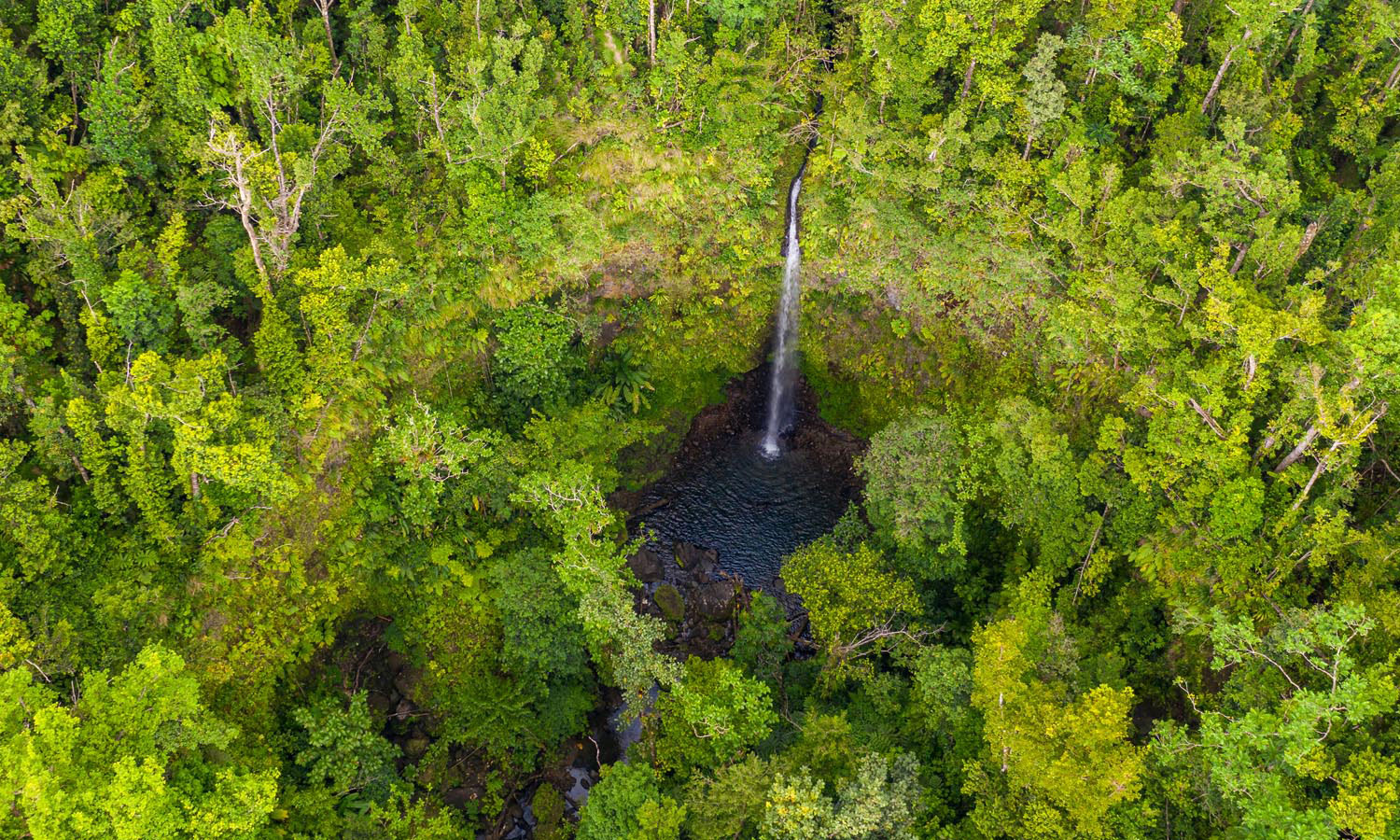There’s a distinct chill in the air. A heavy dew clings to the low-growing montane thicket, the slender tree ferns, and the mountain palms. Clusters of ground orchids ease open their lilac petals as the sun slowly rises above the Soufrière Hills, illuminating the surrounding peaks of the Morne Trois Pitons National Park, a UNESCO World Heritage Site since 1997. A blue-headed hummingbird — one of four hummingbird species recorded on the island — dances around a flowering bromeliad, and the lonesome call of the rufous-throated solitaire, known locally as mountain whistler, echoes from afar. It’s a solitary bird, usually well-hidden within the deep creases and folds of Dominica’s heavily forested interior.
The morning is still. There’s no one else here, and I’m in perfect isolation.
The narrow track is somewhat overgrown. Few have passed this way recently, I suppose. Beneath me, through a tangle of branches that support the thick palmate leaves of kaklin shrubs, is Freshwater Lake, silent and serene, its unruffled surface reflecting wispy clouds and the imposing mornes — an old French word for small mountains. Cresting a ridge, I pause to take in the view. To the east is the Atlantic Ocean and the rugged shoreline of Rosalie Bay. To the south are the volcanic summits of Morne Watt and Morne Anglais. To the west, imposing Morne Micotrin fills my field of view. And to the north is the majestic, three-peaked summit of Morne Trois Pitons itself.
Standing here alone, surrounded by a magnificent wilderness of forest, lake, and dormant volcanoes, unchanged and unmoved for thousands of years, I can easily transport myself to another moment in time, when the world was perhaps a less troubling place.
Dominica’s remote wilderness tracks, its hiking trails, waterfalls, and hidden crater lakes, are beautifully natural places where the air is fresh and untainted, and where the water is so clean and clear, you can drink straight from mountain rivers and streams. Such wild places, in abundance on this island, offer escape, social distancing on a grand and spectacular scale, and an inestimable feeling of freedom.
This morning, I’m walking along the Freshwater Lake loop trail. It’s a short, hour-long hike, and relatively easy compared to many other, more challenging tracks in the eastern Caribbean’s “Nature Island.” Freshwater Lake sits in the middle of an expansive caldera — all that remains of a massive long-ago eruption, when a huge volcano blew its top. It’s the largest of the three named crater lakes in this protected park — the others being secluded Boeri Lake and the fabled Boiling Lake — a bucket-list hiking trail for serious walkers.
This track is familiar. I’ve walked it many times over the years. In addition to its fabulous volcanic scenery, the low-growing montane flora all around are lush and plentiful, with dense thickets and a wide variety of water-loving plants and lichens, and mountain flowers that attract birds, anole tree lizards, and foraging agouti. Like many of Dominica’s wilderness tracks, the Freshwater Lake loop trail is a path for nature buffs as well as hikers, and a knowledgeable local guide can transform a pleasant walk into a natural history education.
The trail is also historic. An adjunct to the ancient Chemin L’Etang or Lake Road — one of the first paths cut across the island to enable the movement of people between the west and east coasts without the need for boats — Freshwater Lake became a natural stopping-off point where travellers would rest overnight, resulting in the establishment of the nearby settlement of Laudat, Dominica’s highest village and now one of the main gateways to the park.
Wild places such as those within Morne Trois Pitons National Park and Morne Diablotin National Park in the north of the island are where it is easy to take time out and swap the digital world for the natural one — to quieten the incessant bombardment of instant twenty-four-hour information, and take it slow. Each park has hiking routes that suit all levels of interest and ability — summit climbs, waterfall and river tracks, nature and heritage trails. Some routes take a half- or a full day, others — like the Freshwater Lake Trail — just an hour or so. Regardless of the trail, total immersion in nature is guaranteed — around two-thirds of Dominica is covered in rainforest — and the well-being it brings is measureless, especially against the backdrop of the times we are living in.
After an hour, I cross a stream and reach the end of my walk. The sun is up now, and a gentle breeze brings ripples to the lake. But there is still no one else here, my social distancing is unbroken, my feeling of escape unsurpassed. I am refreshed, rejuvenated, and ready for another day.
Paul Crask is a Dominica-based journalist, published travel writer, and independent magazine publisher
Caribbean Airlines operates four flights each week to Dominica from Barbados, with connections to other destinations.
Dominica’s borders are open, and the country welcomes regional and international travellers. For information on travel requirements and arrival protocols, see www.domcovid19.dominica.gov.dm/faq-s/travel-protocols-for-entry-into-dominica























